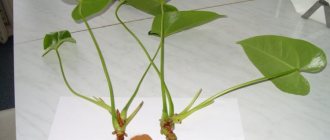Recently, clivia, a spectacular ornamental plant with beautiful bright bell-shaped flowers, has become increasingly popular in home floriculture.
In the wild, the flower grows in the humid subtropical forests of South Africa, from where it was exported. Clivia has become widespread due to its ability to adapt to environmental conditions, which is why it is quite unpretentious in care. In addition, clivia is one of the few indoor plants that amaze with their bright and lush flowering in winter.
In order for the plant to develop properly and bloom annually, it needs to be provided with comfortable conditions throughout the year and disturbed as little as possible. With proper care, the plant can live a very long life - up to 40 years.
Indoor flower Campanula - description
Campanula is a herbaceous perennial plant. From its appearance it is easy to notice that it is a relative of the well-known bells; even one of the varieties of campanula is called “equal-leaved bell.”
Campanulas include more than two hundred plant species. Officially, they are called campanulae, but there are several popular names: firstly, they are called “bride and groom” because of their characteristic blue and white coloring, and also as shooting stars.
There is also a legend associated with the name that campanulas are called bells not because they look like bells, but because once upon a time the first church bell in the world was invented, inspired by the outlines of these flowers.
What does the Bride and Groom flower look like?
Visually, the flower looks like a small bush. A straight shoot of Campanula can only grow up to 15 centimeters, and then it begins to spread, so Campanula is an ampelous beauty, this plant is ideal for growing in a cache-pot (hanging pot). But you shouldn’t try to “twist” the campanula around a support like a vine; it’s not intended for that.
As a rule, campanulas have long shoots, up to half a meter. The stems are thin, the flowers are too heavy for them, so if the shoots are long, they bend down. But if you do not allow the campanula to grow above 15 centimeters, then it grows as a small, lush bush.
The characteristic bell-shaped flowers exude a pleasant aroma. The colors of the buds are very different, but most often they are white, blue, lilac or pink. Terry campanula is also sometimes found.
The leaves are small and usually heart shaped. The length reaches 7 centimeters, sometimes with jagged edges.
Flowering Campanula: how, when and how long it blooms
From April to October. The first two to three years of life the plant blooms profusely, then the flowering thins out, so the flower is replanted by dividing the bush.
Where it grows - the birthplace of the plant
Distributed throughout the world, but most of all in the Mediterranean climate.
Plant species
There are more than three hundred species of Campanula in the family, but only a few are cultivated.
Campanula equifolia
Grows no higher than 30 cm. Can be grown as a hanging crop. Thin shoots of this type of flower are lowered down under the weight of leaves and bell flowers. The shape of the leaves is carved, the cuttings are long. The abundance of flowers on the shoots is blue and white. The plant even has a name: “bride and groom.”
Blauranka campanula
It grows no more than 20 cm, but is distinguished by large leaves and large open flowers. The flowers are represented by pale blue bells. This crop is often used for growing on loggias and garden plots.
The blauranke variety reaches 20 cm in height and has pale blue flowers up to six centimeters in diameter.
Terry campanula
It was bred by breeders and is therefore considered a hybrid. Unusual flower: on one bush you can see a variety of bells, differing in white, blue, and purple colors. The leaves are carved; due to their abundance, thin stems are almost invisible on the bush. But this plant is very capricious to care for. And not every gardener can grow this flower.
Carpathian campanula
Blooms almost all summer. The colors of bells can vary. The leaves are round in shape and grow from a rosette.
View of Pozharsky
A distinctive feature of the poscharskyana species is the almost regular round shape of the leaves. The flower has long shoots that creep along the ground. The flowers are small, no more than 2.5 centimeters in diameter.
Rich purple hue. The variety tolerates cold and can grow in the shade.
Garganskaya
]
Compact species, spreading along the ground. The flowers are blue, up to five centimeters in diameter. Grows well in the shade. Blooms in autumn.
Prialpiyskaya
A very low - up to 10 cm - plant that has small buds of bright blue color. Flowering is long and beautiful.
spoonleaf
Quite a tall species - the stems reach 20 cm in height. The leaves are small, no more than five cm. At the same time, the flowers can change shade - from rich cobalt to white.
How to care for Campanula at home
Campanula is not a capricious plant, but you must follow certain care rules so that the flower will delight you with its beauty longer.
Replanting after purchase
Immediately after purchase, within the first two to three days, you need to move the campanula to a new pot. The reason for such an urgent transplant is that in the store they keep it in hydroponics, which is not suitable for permanent cultivation of this plant: the campanula will not bloom, and may even die. The transplant is carried out as standard, its rules are described below, section “Transplant”.
You also need to keep the campanula in quarantine for at least two weeks, or better yet, a month, separately from other flowers, to prevent them from being infected by pests from the “new one,” since flower shops are fertile ground for parasites.
Lighting
Abundant, but scattered. Windows facing east or west are good; south-facing windows have too much lighting. When the sun comes, the campanula needs to be shaded (cover the window with a curtain, move the flower into the shade, or even move it to another, more shady room) to avoid sunburn. On a north window, the plant will need additional lighting, for example, ultraviolet lamps.
Also, the campanula can be taken out to the balcony or to the plot in the summer, but if bad weather breaks out - thunderstorm, rain, strong wind - the pot needs to be taken home. In the fall, even before the first frost, the flower is returned home for good.
Temperature
In winter – 14-16⁰С, in summer – no more than 25⁰С, ideally – a little more than 20⁰С.
In winter, it is better to move the campanula into a flowerpot or hanging pot so that it does not overheat on the windowsills, under which the radiators are usually located.
Humidity
Campanula is not picky about humidity, but it will be grateful for spraying or a humidifier in the room. Plus, spraying is a good preventative measure against most pests that prefer dry conditions.
How to water the flower “Bride and Groom”
Everything is traditional: settled water at room temperature, perhaps with the addition of charcoal. Water carefully, so that the water only gets on the soil, but not on the buds.
In summer
As the warmer months arrive, watering increases to once a week. Please note that campanula tolerates drying out more easily than overwatering; there is no need to overdo it with watering.
in winter
Watering becomes less frequent - twice a month.
Fertilizer and feeding
Feeding begins in March and continues until August. Feeding frequency: once every 14 days, or once a month, with complex fertilizer. Do not overfeed, as this may even kill the campanula.
Do not feed in winter - in winter the plant goes dormant.
Trimming and shaping the house bell
Pruning time is October-December. You just need to trim the bush by 12 centimeters to rejuvenate it and make it bloom more profusely.
During transplantation, pruning is also carried out: dried shoots are removed, leaving only 5 cm of them. Then new shoots will grow from these remaining parts.
Types for growing in a pot with photos
There are several types of perennial plants suitable for growing at home.
Cinnabar, miniata or orange
Clivia miniata is the most popular potted variety, which has become the basis for the selection of new varieties.
In nature it grows in high mountain shady areas. The height of the plant is within 50 cm. The leaves are dark green, ribbon-shaped, and the peduncle grows up to 30 cm in length. Each inflorescence consists of 20 funnel-shaped buds of red or bright orange color with a yellow core. The petals are elongated, about 5 cm. It can bloom from February to May, as well as at other times of the year, for example, in autumn.
Gardena
Clivia gardenii lives in the shady African foothills and differs from other species in having slightly lighter leaves with longitudinal stripes. The flowers are narrow, no more than 3 cm in length, bell-shaped, collected in inflorescences of 15 buds of a pale or bright orange hue, often with a greenish border along the edge of the petals. Blooms in winter.
Beautiful or noble
Clivia nobilis is native to the Cape region of Africa. This is a more compact species, exceeding 30 cm in height. It has a thick, dense peduncle containing from 40 to 60 small, no more than 2 cm, soft pink buds. The flowers are funnel-shaped with petals with a pointed green top.
Blooms from mid-winter and throughout spring.
Variegated or white
Clivia variegated is an artificially bred species, about 70 cm high, with long fleshy leaves. About 20 white-cream bell flowers are collected in inflorescences on high peduncles. Blooms closer to summer.
Powerful
Clivia robusta is found naturally in wetlands, has wide leaves up to 12 cm and can reach a height of about 180 cm.
In appearance it is similar to beautiful clivia, but is significantly larger in size.
Stem
Clivia caulescens is a giant species with a two-meter false stem formed from drying lower leaves and long aerial roots. In the wild it grows in the damp rocky soil of the African region of Mpumalanga. It blooms in summer with orange flowers with greenish edges, hanging in clusters of 15-20 pieces. Due to its size, it is more often grown in greenhouses than at home.
Citrina
Clivia citrina (C. miniata var. citrina) belongs to the breeding variety of cinnabar clivia. A low plant, about 60 cm, has soft cream flowers with a charming aroma and yellow berries.
Amazing
Clivia mirabilis naturally grows in arid areas and can tolerate both high temperatures, up to 40 °C, and light frosts. The plant reaches a height of no more than 60 cm, the flowers are in the form of red-orange bells. Has a powerful rhizome.
Reproduction of Campanula at home
Campanula is grown for its beautiful flowers, but after 2-3 years they thin out significantly. After this, the campanula is planted and a new plant is grown, which has not yet lost its decorative effect. This can be done by cuttings, dividing the bush, or grown from seeds.
Cuttings
You will need:
- A well-sharpened tool so that you can carefully cut the stalk;
- Alcohol to disinfect tools;
- Some of these: cinnamon, finely crushed chalk or ash. This is necessary in order not to infect a new plant with anything through an undisinfected cut.
- A container for rooting in water, water itself, a weak solution of potassium permanganate.
- Spray.
- A small container, soil for campanula (universal soil for indoor plants is suitable, no special one is needed).
- You can, but not necessarily, use plastic film, a cut plastic bottle or a glass cap to create a greenhouse.
What should be done:
- Cut the stalk with leaves, you want it to look healthy, juicy, and beautiful. Cut it from the bottom of the campanula. The cut is sprinkled with cinnamon, chalk or ash for disinfection.
- Place it in a solution of potassium permanganate for a short time, and then in a vessel with just clean water.
- Water needs to be added periodically, because the sprout will drink it.
- In two to three weeks, roots will appear - then it will be possible to transplant the sprout into the ground. If you want rooting to happen faster, cover the sprout in water with a greenhouse, but then it needs to be ventilated daily and the condensation washed off.
- A sprout in a container, until it grows to an adult plant, can only be watered through spraying, from a spray bottle.
Dividing the bush
All you need is a sharp knife, alcohol, disinfectant powder, and a pot for the new bush.
It’s simple: you pull the mother plant out of its previous “house”. After this, divide it into two or three plants using a clean tool. You plant the delenka in a new “house”. She does not require special care. If you want it to grow more luxuriantly, then cut off its tops, but this can only be done if the bush is not lower than 12 centimeters.
Growing from seeds
This is also a fairly simple method; you don’t need to fuss with campanula seeds as much as with the seeds of other plants.
Seeds are easiest to buy than to get yourself. You will need a box where you will pour the soil (a universal one will be suitable for indoor plants, a separate one is not needed for seedlings). Sprinkle the seeds on it, then sprinkle a layer of river sand on top.
If you want to speed up germination, cover the container with a greenhouse: plastic wrap or a glass cap. It needs to be ventilated daily, while removing condensation with a cloth. The soil must be sprayed (in any case, if there is no greenhouse, then spray it too).
The seedlings will appear in two weeks, and when they have three leaves, they can be plucked.
Reproduction of Campanula
These amazingly tender bells can be grown by sowing seeds, cuttings from campanula, or by transplanting by dividing the bush.
Propagation by seeds
Seeds need to be sown in early March.
- The seeds are very small in size, so they can be sown both in small boxes and in cups. The soil in these containers consists of dry soil, such as leaf soil, which is laid out at the bottom.
- Peat soil is laid on top and watered.
- Next, lay out the seeds and lightly press down. There is no need to sprinkle them.
- The top of the container is covered with film or glass.
- Every day, until the seedlings appear, open the containers, ventilate and spray if necessary.
- When shoots appear, the cover is removed.
- After the growth of 4-6 leaves, the seedlings dive.
Dividing the bush
When the campanula is ready for transplantation, this is the moment when the bush can be divided into parts. Using a knife, cut the flower root into several sections. The cut area must be treated with crushed activated carbon. Each division is planted separately and grown as an adult plant. If the bush is young, then it is divided only into two parts.
Campanula cuttings
If you want to grow campanula from cuttings, then this should be timed for the beginning of autumn.
- To do this, a strong shoot with leaves is selected at the bottom of the bush. It is cut off and the cut end is placed in a manganese solution for ten hours.
- When whitish roots appear, the cuttings are placed in a glass of cool water for several hours.
- Next, prepare a small container with a soil mixture of peat soil and sand.
- Cuttings are planted into it to a depth of up to three centimeters. You can plant several pieces in one container. For rooting, cover the container with film.
It is necessary to ventilate and spray the sprouts periodically. They are transplanted into a new container in March. Plant by transfer method, trying not to scatter the soil ball around the roots.
Campanula transplant
In general, campanula is rarely transplanted. It does not tolerate transplantation well, plus there is no particular point in growing it for a long time: after a couple of years, campanula loses its decorative effect - it does not bloom so profusely, so it is easier to root it and start growing a new, young plant than to bother with replanting. Moreover, planting campanula in a new pot is difficult.
However, sometimes a transplant is still required: for example, to cure the campanula from pests or rot, or if it has grown out of a pot (or vice versa, the pot is too big for it, and this is harmful to flowering), immediately after purchase. Here's what you need to do to transplant:
- Prepare material for drainage, soil, and a new container for the flower in advance. All these items must be disinfected - this will prevent the appearance of harmful insects and parasites. The soil is disinfected by calcination (kept in an oven preheated to 100⁰C for about half an hour, and then left in a well-ventilated place for two weeks), and the pot is simply washed thoroughly with soap.
- Fill the pot a quarter full with drainage.
- Water the campanula generously - this is necessary to make it easier to remove it from the old pot. Carefully pull it out and inspect the roots to see if there are any rotten parts there. If there are, then remove them with a sharp knife, which must also be wiped with alcohol first.
- You also need to cut off the lower part of the roots, where they are intertwined and matted. Make cuts on the sides 3-5 mm deep - this will help the root system to grow more actively, making it easier to transplant.
- Place the campanula in a new pot. Gently holding it, pour the soil to the top, then press it lightly and compact it.
- Water the flower and put it in a shady, cool place, let it adapt. When the flower begins to grow again, place it in its usual place.
When to replant
Early spring or late autumn. They are usually replanted either because pests have infested, or because the plant has outgrown the pot, or, on the contrary, the pot is too large. The first is noticeable by the roots protruding above the ground, and the second by the fact that campanula does not bloom, although it has abundant foliage.
Priming
You can use universal soil for ornamental flowering plants, you can make it yourself: mix leaf soil with peat in equal quantities, or (also in equal quantities) mix river sand, humus, peat and a universal soil mixture for flowering plants.
Pot
“Dish” format: shallow, but wide, because the root system of the campanula grows in breadth, not in depth.
- If you are replanting a campanula because its root system no longer fits into the old pot, the new one should be 3-5 cm wider.
- If the reason for replanting is fattening (this happens when the flower pot is too big), then 3-5 cm less.
Is it possible to plant campanula in open ground?
Yes, you can, both seedlings and seeds. It needs to be planted in an open place where there are no trees or shrubs.
Campanula diseases with photos and their treatment
Root rot
Symptoms: the leaves turn black at the base, wet brown spots appear on them, which quickly increase in size. The soil becomes moldy and the plant smells bad.
What to do: it is necessary to transplant the campanula. In this case, you need to do the following:
- Remove all damaged parts of the plant. Trim them back to a few healthy areas, as these may also contain fungal spores. Pruning is carried out with a sharp, thoroughly disinfected tool, because otherwise you can only make the situation worse.
- The sections must be sprinkled with a disinfectant. Typically, ground activated carbon or ash is used for this. You can also use cinnamon or chalk.
- Immerse the campanula roots in water with a fungicide dissolved in it for half an hour. Then let the roots dry.
- After this, it is necessary to transplant the campanula into a sterilized pot and soil.
- Then for two to three months add medicine - Baikal-Em or Pervikur - to the water for irrigation.
Why does root rot appear: due to excessive watering.
Gray rot
Symptoms: wet gray spots, which soon develop a fluffy coating with black specks.
What to do: it is necessary to cut off all damaged parts and disinfect the cut areas. Then spray the campanula with fungicide and repeat spraying every 3-4 months.
Why does gray rot appear: also due to high humidity, a preventive measure in the case of any rot is to carefully monitor the watering regime and avoid overwatering the plant.
Other problems
Campanula can also indicate a reaction to improper care. What reaction and how to deal with it?
- Faded leaves and translucent spots of indeterminate shape on them are symptoms of sunburn, which often happens after spraying if you leave the plant with drops of moisture on the leaves, since the drops act like lenses. Solution: move the campanula to the shade, it will recover itself.
- Thinning leaves, they become smaller and grow less often - this indicates a lack of light. Solution: you need to move the flower to a sunnier place or organize ultraviolet radiation lamps for it.
- Drooping, weakened leaves most often indicate that the soil is over-moistened or that you regularly forget to drain the water from the pan. Solution: These aspects of care need to be adjusted.
- Blackening of the leaves at the base is the development of rot, you have already read about it before. Preventing rot is carefully following watering recommendations. It is also important to prevent the campanula from overcooling; cold combined with moisture are ideal conditions for the development of rot.
- The campanula does not bloom, or does not bloom profusely enough - this indicates either problems with fertilizers (insufficiently frequent fertilizing, or inappropriate preparations), or a pot that is too large - the campanula fattens, grows leaves, but does not bloom.
- Drying and falling leaves indicate that you are watering the campanula too rarely, or the air is too dry, or it is exposed to drafts. Solution: it is necessary to increase the frequency of watering, remove the flower from the ventilated place and place a container of water nearby so that it evaporates, or introduce or increase the frequency of spraying.
Campanula pests
The following pests are characteristic of Campanula:
Spider mite
Symptoms of appearance: first of all, it is a very recognizable coating, similar to a thin cobweb. Usually appears on the lower parts of plants, on the underside of leaves. In addition to such plaque, the appearance of spider mites is indicated by pale spots of uncertain shape on the underside of the leaves.
What to do: first you need to remove all insects from the plant. This can be done as follows: apply alcohol to the plant with a brush, and then wash it off after 10-15 minutes.
You can use a folk remedy: organize a greenhouse. That is, spray the campanula, water it generously and wrap it in plastic wrap or place it under glass. In three to four days, the insects will die because they cannot tolerate humidity. However, this method only helps with minor damage. It is safer to use chemicals: for example, Apollo or Fitoverm or other insecticides. They are used several times, usually three or four. There should be at least a week between uses. The most profitable strategy is to change the preparations, using a new one each time, because insects easily adapt to chemical exposure.
Prevention: spider mites appear when the environment is warm and dry, so if you have Campanula near heating appliances, bookcases, curtains (dust accumulates there), then inspect it regularly, especially the lower parts and undersides of the leaves, and do not forget to either spray the plant , or place a container of water next to it so that the water evaporates and prevents the air from drying out.
Shchitovka
Symptoms: growths, bumps of different shades of brown on the leaves, bordered with yellow-red. They grow quickly and tend to merge.
What to do: thoroughly rinse the plant under a warm shower and then treat it with insecticides. You will have to carry out at least 3 treatments with a break of a week to allow the campanula to rehabilitate. It is difficult to fight scale insects because they have a shield on their back that protects them from chemicals, so you have to use different drugs and even cross-treat with two types at once for greater effect.
Prevention: scale insects start up, as a rule, by accident, so the only thing to do here is to regularly inspect and keep the area around the plants clean, remove dried leaves in a timely manner, because dirt always increases the risk of insects appearing.
Aphid
Symptoms: Aphids are visually noticeable and very recognizable - they are pale green or brown insects that appear on leaves, usually right on the central vein.
What to do: Rinse the plant thoroughly in the shower. Then inspect it and cut off those leaves that have suffered the most (aphids drink juice from leaves, so especially “gnawed” leaves will be pale, drooping, with traces of vital activity), always with a sharp, disinfected instrument, so as not to introduce infection into an already weakened plant. Next, treat with aphid preparations; usually three to five treatments are required with a break of a week.
Prevention: the same as with scale insects. Also, do not allow ants to appear in your apartment, because aphids usually appear after the ants.
Whitefly
Symptoms: Like aphids, whiteflies are visible visually - these are tiny white butterflies that fly up from the campanula when touched.
What to do: Cover your campanula with sticky insect traps, remove adult whiteflies with a vacuum cleaner, and treat the plant with insecticides.
Prevention: monitor the microclimate in the room. Whiteflies do best where it is both warm and muggy, or where plants are very close to each other. Do not allow such conditions to form.
What you need to know about pests in general
- Most often, they start by accident: they fly into a window, you pick them up on your shoes or pet’s fur, if you have one. However, they take root if the apartment has a suitable microclimate. Most pests prefer high temperatures and dryness, so the most dangerous time is when heating devices are working; flowers that stand near heating devices are also at risk.
- It is important to regularly inspect plants to spot insects in time. Fortunately, most pests of Campanula are visible visually; it does not suffer from root parasites, the presence of which is noticeable from the outside only at a severe stage of damage. Pay special attention to the lower parts of the plant and the undersides of the leaves.
- Make sure that the conditions required by the campanula are observed. Care and careful cultivation of flowers is the best prevention against parasites.
- Each parasite requires its own medicine, so it is best to take a photograph of the insects and bring the photo to the seller - he will select the right medicine and instruct you on how to use it, because often medicines need to be used in smaller doses than indicated on the package, it depends on the plant.
- The scheme for controlling all pests is the same: first, mechanically remove all the insects that you can find, and then treat them with chemicals.
- If you find insects on one plant, immediately move it away from other flowers and carefully examine the remaining ones - perhaps they are also already infected. This is necessary for isolation, because insects easily jump from flower to flower. For the same reason, you need to keep new plants in quarantine, because you can bring infected campanula from the store.
- In case of pest infestation, replanting is recommended, because most insects lay eggs in the soil, that is, it becomes infected.
General rules for pest prevention
- Quarantine for newly purchased plants;
- Regular inspection of plants;
- If you notice something suspicious, immediately isolate this plant from others;
- It is undesirable to keep many plants in one place; this is fertile ground for the appearance of pests;
- Ventilate the room where campanula grows, wipe off dust from the leaves, spray them;
- Disinfect all things that will interact with campanula: new soil for planting, pot, propagation tools;
- Carefully follow the rules for caring for your Campanula.
Popular types of campanula: photos and names
Campanula is a very beautiful plant. Its main beauty lies in the bright colors of the buds. Here are the types of campanulas:
Campanula Alba
Bride. A snow-white ampelous variety with bright, rather large buds, shaped more like a chamomile than a bell. Their color is boiling white.
Campanula Maya
Groom. The buds of this ampelous variety are also quite large, with a delicate lilac hue, reminiscent of warm summer twilight.
Campanula Cirillo
An ampelous variety, similar to the previous one, but the shade is closer to blue than to lilac, like a slightly hazy summer sky in the early morning.
Campanula Dublin
This variety comes with white flowers (Dublin White), blue (Dublin Blue) and bicolor (Dublin Bicolor). There are bush varieties and semi-ampelic ones.
The bicolor variety has soft lilac leaf tips and a white-yellow core, making the flowers look like stars.
Campanula Get mi
This variety is predisposed to grow in the form of a bush, its shoots stretch upward. The color of the buds depends on the variety: bright purple, violet, rich (Campanula Dark Get Mee), white (Campanula White Get Mee)
Campanula Napoli
The flowers are deep blue, large, up to 5.5 cm in diameter. The leaves are heart-shaped with a serrated edge. There are bush and semi-ampelic varieties.
Campanula Porto
Another bush variety that looks great in a flowerpot: like a whole heap of bright purple stars. Depending on the variety, the flowers are blue-violet (Campanula Porto) or white with a lilac tint (Campanula Porto Ice White).
Campanula Bali
This variety has a terry bud shape: they are not bell-shaped, but rather look like tiny roses. There are varieties with soft blue, smoky flowers (Campanula Bali Blue) and white (Campanula Bali White). Grows as a bush.
Campanula Wonder
This variety is similar to the previous one: a bush variety with double rosette flowers, but more compact. Depending on the variety, the color of the buds can be snow-white (Campanula Wonder White) or blue (Campanula Wonder Blue).
Campanula Berlin
This variety is distinguished by large buds in the shape of a five-pointed star, with soft lilac tips and a snow-white core.
Campanula of Pozharsky
And this variety has smaller buds with thin petals, also shaped like stars. Blooms wildly and abundantly. There are a lot of varieties, the color of the buds is white or all shades of blue.
Description of the bell
This plant grows in Asian and European countries, in the Caucasus, and on the slopes of the Alps. These can be meadows, forest belts, forest edges, or mountain slopes. Campanula grows no higher than 50 cm in height.
Depending on the species, the shapes of the leaves vary: from oval to leaves with elongated hearts.
The color of the flower is also different; there are flowers of white, pink, lilac, and dark purple.
Flowers can grow one at a time or can be collected in inflorescences. They are located on the tops of the shoots. The shape of each flower is represented by a bell with bent edges.
People often wonder where to buy campanula seeds. They are sold in all specialized flower shops.
What does the Bride and Groom flower bring to the house: signs and superstitions
House bells are surrounded by signs and superstitions, but most of them are absolutely positive. First of all, let's figure out why this flower is called “bride and groom”.
This name comes from the most popular Campanula flowers. The fact is that most often two varieties, two varieties are grown next to each other: blue or blue campanula and next to white - white campanula. Plus, many varieties on their own, without the intervention of a gardener, grow two-colored bells, blue and white.
Together they evoke an association with the groom (blue campanula) and the bride (white). And in the wild, a bell-shaped flower most often grows this way. So it stuck.
And because of this, the first sign appeared: it is believed that house bells bring harmony, comfort and happiness to the house, reconcile spouses, help them build more harmonious relationships, and help single people find their other half.
What other signs are associated with campanula, as evidenced by reviews from people who believe in the influence of plants on the life, health, and well-being of the owner?
- Homemade bell flowers are often used in wedding ceremonies: campanula is used to form bouquets for brides, decorate the hall with them, and an indoor flower with bells can also be given as a gift. And this is considered a positive sign: if a campanula is given to newlyweds, then they will live happily ever after, in love and harmony, complementing each other, like Yin and Yang.
- And if an unmarried girl begins to grow campanula and carefully care for it, then she will quickly have a lover or at least a boyfriend. In ancient times, bells were even attached to window frames, shutters, and a skirt was decorated with them if they wanted to find a loved one, and the sign has been preserved to this day.
- Campanula brings good luck. Sometimes it is placed under the heel on special days when you need a little luck. True, the campanula does not tolerate liars, so it is important, if she accompanies you, not to deceive anyone. Otherwise, the flower, of course, will not harm you, but it will not attract good luck either.
- Although this home flower blooms with bells, they, of course, do not ring. But they say that if you listen to the campanula on Ivan Kupala and hear how it rings like a bell, then from that moment on you will experience continuous success, pleasant coincidences, and fate will always smile on you.
- Flowering campanula - to good news and events.
- But if Campanula doesn’t bloom... Even this is a good omen! This means that the owner of the flower will soon get married. This surprisingly distinguishes Campanula from other plants that do not bloom in anticipation of imminent negative news or events.
- If you dreamed of a campanula, this means pleasant changes. However, if you saw her in a dream in the summer, it means that you will soon commit a rash act, and you will have to face its consequences.
- The houseplant campanula, like many other houseplants, concentrates negative energy on itself, protecting household members from it. It also drives away evil spirits and people with evil thoughts.
- If you plant campanula on the street near the house, it will attract prosperity and financial well-being to the house.
- According to Feng Shui philosophy, the campanula should be located in the eastern part of the apartment or house. It is there that the flower will begin to attract positive energy into the house, aimed at improving financial well-being. However, it is important that it is a healthy, strong flower; if the campanula is rotten and withered, then it will not bring any positive energy to the house.
As you can see, the campanula is mainly surrounded by exclusively positive energy. Are there any negative signs associated with Campanula? Yes, but there are not many of them.
Firstly, if the campanula suddenly and sharply withered, although everything was fine, and care for it was organized carefully and accurately, this is bad news, an unexpected disaster. And in England they believe that you should not pick the campanula - this will lead to quick and inevitable death.











